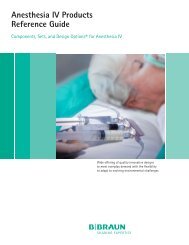PDF [0.44 MB] - B. Braun Medical Inc.
PDF [0.44 MB] - B. Braun Medical Inc.
PDF [0.44 MB] - B. Braun Medical Inc.
Create successful ePaper yourself
Turn your PDF publications into a flip-book with our unique Google optimized e-Paper software.
CARESITE Luer Access Device:<br />
Microbial Barrier Performance of the Needleless Connector<br />
Abstract<br />
Numerous factors may contribute to the risk of bloodstream infections including design of the connection surface, internal<br />
mechanism of the device, extreme variations in healthcare worker’s techniques for cleaning the device, and lack of sterility of<br />
intravenous (I.V.) administration sets used intermittently for extended periods of time. 9-11 No study has identified one factor as<br />
more important than the others in creating the risk for these infections. Following the recommendation for microbial ingress<br />
testing from the United States Food and Drug Administration (FDA), twenty-four (24) test samples of CARESITE, 24 control<br />
device of ULTRASITE®, along with positive and negative controls in each group were studied. This study demonstrates that<br />
the CARESITE LAD prevents passage of most organisms through the needleless connector following thorough, well-defined<br />
cleaning before each use.<br />
Background<br />
Needleless connectors have enhanced the safety of healthcare workers by eliminating the use of needles for making numerous<br />
connections between intravenous administration sets, syringes, and the catheter hub. The BloodBorne Pathogens Standard<br />
from the Occupational Safety and Health Administration mandates their use. 1 While they have reduced needlestick injuries,<br />
the increasing use of these devices has generated concern about the patient’s risk of bloodstream infections. 2-8<br />
CARESITE is a needleless connector with a split-septum plunger surrounded by the external housing that includes a luerlocking<br />
mechanism. Fluid flows through the opening in the center of the split septum, then around the collapsible center post.<br />
An independent laboratory tested the CARESITE LAD to quantify the risk of transfer of organisms through the device.<br />
Methods<br />
Following the recommendation for microbial ingress testing from the United States Food and Drug Administration (FDA),<br />
twenty-four (24) test samples of CARESITE, 24 control device of ULTRASITE, along with positive and negative controls in each<br />
group were studied. All needleless connector samples were twice sterilized using ethylene oxide prior to testing.<br />
The CARESITE test devices and the positive control devices were challenged with four (4) species of organisms including<br />
Staphylococcus aureus, Staphylococcus epidermidis, Pseudomonas aeruginosa, Escherichia coli. The ULTRASITE samples<br />
were challenged with Staphylococcus aureus. All species were supplied by ATCC, a major provider of microorganisms for<br />
scientific testing purposes. All species were prepared using the same process. To ensure adequate viability of the organism,<br />
fresh solution was prepared daily using the same procedure. The challenge organism was incubated for 18-24 hours at 30-35<br />
degrees C. The organism was harvested from the agar surface using sterile saline and sterile cotton swabs. The suspended<br />
organism was washed using centrifugation at 20 to 25 degrees C for no longer than 10 minutes. The organism pellet was<br />
suspended in fresh sterile saline, washed a second time, and then suspended again in fresh sterile saline. The concentration<br />
of the challenge organism was measured spectrophotometrically and diluted to yield a final concentration of 10 5 (100,000) to<br />
10 6 (1,000,000) colony forming units per milliliter (CFU/mL) of solution.<br />
Rx only. ©2010 B. <strong>Braun</strong> <strong>Medical</strong> <strong>Inc</strong>., Bethlehem, PA. All rights reserved.<br />
www.bbraunusa.com<br />
CS07_9/10_EB
The CARESITE Luer Access Device: Microbial Barrier Performance of the Needleless Connector (Cont’d)<br />
The inlet or connection surface of the 24 test devices were inoculated with 0.01 mL of the challenge organism solution and<br />
allowed to set for 60 seconds. After inoculation and the set period, the connection surface was cleaned with a new 70%<br />
isopropyl alcohol pad using a twisting action clockwise and counterclockwise for 15 to 20 seconds. Care was taken to avoid<br />
depressing the internal piston while adequately cleaning the surface. The alcohol pad was discarded and the connection<br />
surface was allowed to dry for 30 to 60 seconds.<br />
This cleaning procedure was performed and followed with a sterile empty syringe being connected, disconnected and<br />
discarded for each test interval Hour-0, Hour-1, Hour-2, and Hour-3. At hour 3, a sterile syringe filled with 10 mL of soybean<br />
casein digest broth (SCDB) was attached and the media flushed through each LAD and collected in a sterile test tube. This<br />
fluid was then filtered through a sterile apparatus using a 0.45-micron filter and the filter flushed with 100 mL of sterile fluid.<br />
This fluid was then plated on a soybean casein digest agar (SCBA). All agar plates were incubated at 30-35 degrees C for 2<br />
to 3 days when colony counts were taken. After being flushed with the SCBD at hour 3, the LAD was flushed with two sterile<br />
syringes both filled with 5 mL sterile saline.<br />
Table 1 - Testing Procedure<br />
Hour Action<br />
Hour 0 Clean connection surface of LAD<br />
Allow to dry<br />
Inoculated LAD connection surface<br />
Allow to dry<br />
Clean connection surface of LAD<br />
Allow to dry<br />
Attach and detach empty sterile syringe.<br />
Hour 1 Clean connection surface of LAD<br />
Allow to dry<br />
Attach and detach empty sterile syringe.<br />
Hour 2 Clean connection surface of LAD<br />
Allow to dry<br />
Attach and detach empty sterile syringe.<br />
Hour 3 Clean connection surface of LAD<br />
Allow to dry<br />
Attach SCDB-filled syringe and flush through the LAD into a<br />
test tube.<br />
Disconnect empty syringe.<br />
Attach a saline filled syringe and flush with 5 mL saline.<br />
Disconnect syringe.<br />
Attach a second saline filled syringe and flush with 5 mL saline.<br />
The positive controls were run concurrently with the test samples in each cohort. Three LADs were inoculated each day using<br />
the same solution and process described above. No cleaning was performed on these devices. The SCDB-filled syringe was<br />
attached and flushed through the device, however one (1) mL of the solution was filtered to obtain a countable range of<br />
organisms.<br />
The negative controls were also run concurrently with the test and positive controls. These devices did not receive the<br />
inoculum step. At hour 3, the final SCDB flush solution was collected in the same manner as the test devices.<br />
This procedure was repeated in the same manner for five (5) days.<br />
Rx only. ©2010 B. <strong>Braun</strong> <strong>Medical</strong> <strong>Inc</strong>., Bethlehem, PA. All rights reserved.<br />
www.bbraunusa.com<br />
CS07_9/10_EB
The CARESITE Luer Access Device: Microbial Barrier Performance of the Needleless Connector (Cont’d)<br />
Results<br />
Table 2 lists the results of the tested CARESITE LAD for all five days. Devices growing greater than 15 colony forming units<br />
(cfu) are reported as this is a primary criterion for diagnosing catheter colonization. 12 Each CARESITE device met these criteria<br />
for all bacteria challenges over the five day test period.<br />
Table 2 - Test Results for CARESITE cohort<br />
Devices growing greater than 15 cfu<br />
Organism Day 1 Day 2 Day 3 Day 4 Day 5<br />
Staphylococcus aureus 0 0 0 0 0<br />
Staphylococcus<br />
0 0 0 0 0<br />
epidermidis<br />
Pseudomonas aeruginosa 0 0 0 0 0<br />
Escherichia coli 0 0 0 0 0<br />
The positive control devices, those inoculated but not cleaned, produced colony counts ranging from 1.1 x 10 2 to 2.0 x 10 3<br />
for staphylococcus aureus. The positive controls for all other organisms were consistently less than 1 x 10 3 cfu per device<br />
although the applied organisms were well above this level. The negative control devices, those that did not receive the<br />
inoculation, showed no growth.<br />
The 24 ULTRASITE control devices were tested using staphylococcus aureus. As stated above, the criterion for diagnosing<br />
catheter colonization is greater than 15 cfu. This has also been chosen as the acceptance criteria for this testing process. All<br />
samples passed this criterion on each day except for two of the control devices which did not meet the criteria on two days.<br />
However, the number of CFUs on these two samples did not increase on subsequent days. Therefore, the nonconformance was<br />
most likely not due to failure of the device to perform as intended. The probable root cause for the failures is likely inadequate<br />
swabbing of the samples being tested. One additional ULTRASITE LAD was tested and showed zero growth on all five days.<br />
The positive control devices, those inoculated but not cleaned, produced colony counts ranging from 1.0 x 10 3 to 8.1 x 10 3 for<br />
staphylococcus aureus. The negative control devices, those that did not receive the inoculation, showed no growth.<br />
Conclusion<br />
This study demonstrates that the CARESITE LAD prevents passage of most organisms through the needleless connector<br />
following thorough, well-defined cleaning before each use.<br />
Discussion<br />
Introduction of organisms is possible with each manipulation of the catheter hub including administration of fluids and<br />
medications, changing I.V. administration sets and needleless connectors, flushing catheters to assess functionality and<br />
reduce lumen occlusion, and drawing blood samples. These procedures can result in excessive numbers of catheter lumen and<br />
hub manipulations, with some procedures requiring multiple connections and disconnections to the needleless connector.<br />
The cleaning and disinfection methods performed in this study are the manufacturer’s recommendation for best practice<br />
to ensure proper surface maintenance of the luer access device. Detailed evidence-based procedures for cleaning luer<br />
connection surfaces have not been established as industry standards. The details of such a procedure should include the best<br />
agent to use, the length of cleaning time, the cleaning technique, and the length of drying time. As seen in the root cause<br />
analysis of the 2 control devices failing to meet acceptance criteria, the disinfection process is paramount in the successful<br />
use of all needleless connectors.<br />
Rx only. ©2010 B. <strong>Braun</strong> <strong>Medical</strong> <strong>Inc</strong>., Bethlehem, PA. All rights reserved.<br />
www.bbraunusa.com<br />
CS07_9/10_EB
The CARESITE Luer Access Device: Microbial Barrier Performance of the Needleless Connector (Cont’d)<br />
It is important that hospitals emphasize the need for aseptic technique when performing these luer connection hub<br />
manipulations. One survey of the critical care units in 10 US hospitals found that 80% addressed hand hygiene in the policy<br />
and procedures for catheter insertion, however only 36% included the same hand hygiene requirements in policies and<br />
procedures for accessing the catheter. 13 One small in vitro study demonstrated that a 15 second scrub with either isopropyl<br />
alcohol or a combination of chlorhexidine gluconate and isopropyl alcohol was sufficient to clean these surfaces of many<br />
needleless connectors. While this length of time may seem difficult to enforce in clinical practice, it has been demonstrated<br />
in vitro that this is effective at killing the bacteria that may be present on the luer connection surfaces.<br />
References<br />
1. OSHA. Revision to OSHA’s Bloodborne Pathogens Standard Technical Background and Summary. In: OSHA, ed. Washington, DC: OSHA; 2001.<br />
2. Danzig L, Short L, Collins K, et al. Bloodstream infections associated with a needleless intravenous infusion system in patients receiving home infusion therapy.<br />
JAMA. 1995;273:1862-1864.<br />
3. Do A, Ray B, Banerjee S, et al. Bloodstream infection associated with needleless device use and the importance of infection-control practices in the home health<br />
care setting. Journal of Infectious Diseases. 1999;179(2):442-448.<br />
4. Kellerman S, Shay D, Howard J, et al. Bloodstream infections in home infusion patients: The influence of race and needleless intravascular access devices. Journal<br />
of Pediatrics. 1996;129:711-717.<br />
5. Maragakis LL, Bradley KL, Song X, et al. <strong>Inc</strong>reased catheter-related bloodstream infection rates after the introduction of a new mechanical valve intravenous<br />
access port. Infect Control Hosp Epidemiol. Jan 2006;27(1):67-70.<br />
6. Field K, McFarlane C, Cheng A, et al. <strong>Inc</strong>idence of catheter-related bloodstream infection among patients with a needleless, mechanical valve-based intravenous<br />
connector in an Australian hematology-oncology unit. Infect Control Hosp Epidemiol. 2007;28(5):610-613.<br />
7. Salgado C, Chinnes L, Paczesny T, Cantey R. <strong>Inc</strong>reased rate of catheter-related bloodstream infection associated with use of a needleless mechanical valve device<br />
at a long-term ac ute care hospital. Infect Control Hosp Epidemiol. 2007;28(6):684-688.<br />
8. Rupp M, Sholtz L, Jourdan D, et al. Outbreak of bloodstream infection temporally associated with the use of an intravascular needleless valve. Clinical Infectious<br />
Diseases. 2007;44(11):1408-1414.<br />
9. Jarvis W, Murphy C, Hall K, et al. Health Care Associated Bloodstream Infections Associated with Negative or Positive Pressure or Displacement Mechanical Valve<br />
Needleless Connectors. Clinical Infectious Diseases. 2009;49:000-000.<br />
10. ISMP. Failure to cap IV tubing and disinfect IV ports plave patients at risk for infections. Institute for Safe Medication Practices. Available at: http://www.ismp.org/<br />
Newsletters/acutecare/articles/20070726.asp. Accessed June 25, 2010, 2010.<br />
11. Hadaway L. Intermittent intravenous administration sets: Survey of current practices. Journal of American Association for Vascular Access. 2007;12(3):143-147.<br />
12. Mermel LA, Allon M, Bouza E, et al. Clinical Practice Guidelines for the Diagnosis and Management of Intravascular Catheter-Related Infection: 2009 Update by<br />
the Infectious Diseases Society of America. Clinical Infectious Diseases. 2009;49(1):1-45.<br />
13. Warren DK, Yokoe DS, Climo MW, et al. Preventing catheter-associated bloodstream infections: a survey of policies for insertion and care of central venous<br />
catheters from hospitals in the prevention epicenter program. Infect Control Hosp Epidemiol. Jan 2006;27(1):8-13.<br />
Additional References<br />
U.S. Department of Health and Human Services / Food and Drug Administration. Intravascular Administration Sets Premarket Notification Submissions [510(k)].<br />
April 15, 2005.<br />
Code of Federal Regulations. 1998. Subpart D - Microbiological Assay Methods, §436.103 – Test Organisms. 21 CFR Ch. I (e-1-98 Ed.).<br />
Kaler, Wendy. Successful Disinfection of Needleless Mechanical Access Ports: A Matter of Time and Friction, Rady Children’s Hospital: San Diego, California: JAVA.<br />
Vol. 12 No. 4. 2007<br />
Rx only. ©2010 B. <strong>Braun</strong> <strong>Medical</strong> <strong>Inc</strong>., Bethlehem, PA. All rights reserved.<br />
www.bbraunusa.com<br />
CS07_9/10_EB


![PDF [0.44 MB] - B. Braun Medical Inc.](https://img.yumpu.com/29517993/1/500x640/pdf-044-mb-b-braun-medical-inc.jpg)
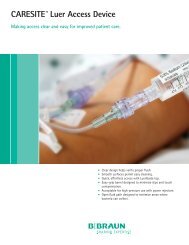
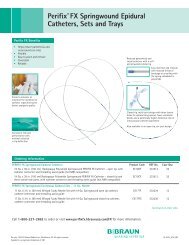

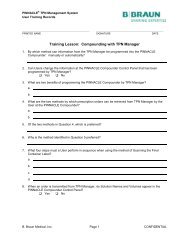
![PDF [2.06 MB] - PINNACLE® TPN Management System](https://img.yumpu.com/40473460/1/190x245/pdf-206-mb-pinnaclear-tpn-management-system.jpg?quality=85)
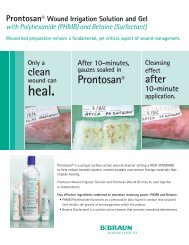
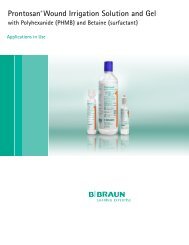
![PDF [0.62 MB] - B. Braun Medical Inc.](https://img.yumpu.com/34866454/1/184x260/pdf-062-mb-b-braun-medical-inc.jpg?quality=85)
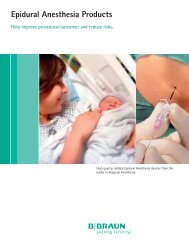
![PDF [2.74 MB] - PINNACLE® TPN Management System](https://img.yumpu.com/33332870/1/190x245/pdf-274-mb-pinnaclear-tpn-management-system.jpg?quality=85)

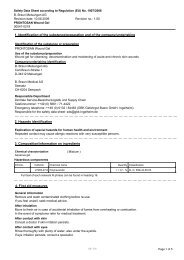
![PDF [0.11 MB] - B. Braun Medical Inc.](https://img.yumpu.com/29255328/1/190x245/pdf-011-mb-b-braun-medical-inc.jpg?quality=85)
